You will love this classic recipe for Raspberry Jam, made with ripe, aromatic berries at the height of their season. The vibrant raspberry flavour is captured in the jam which is a perennial favourite. This is the ultimate way to preserve these beautiful berries to enjoy throughout the coming months, and it truly is so easy.
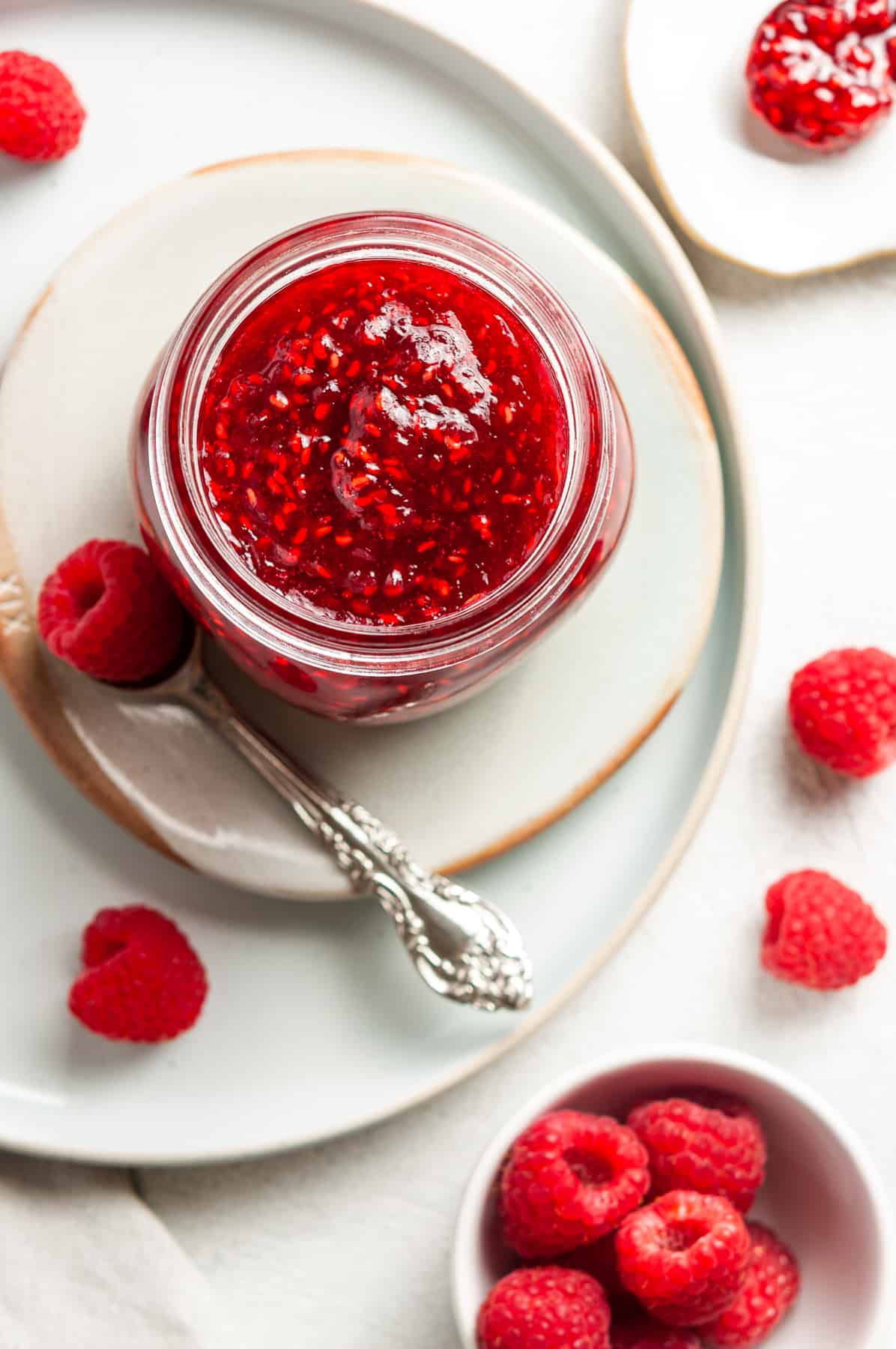
Jump to:
Why we love this recipe:
My simple, traditional recipe contains just three ingredients; raspberries, sugar and lemon. It is not necessary to add pectin to get the jam to set. This is a recipe that has been made by generations in our family.
As well, by making a small batch, the boiling time is short and the fresh vibrant flavour is retained.
You may feel that jam is difficult to make. Let me assure you that it is not. If you have not previously made jam, this is a great one to start with. I will show you how to do it with step-by-step instructions. You will be surprised to discover how quick and easy it is to make your own Raspberry Jam. Plus, when you finish and see your own produce lined up, you will know that it was time well spent.
You’ll love this recipe because:
- Jam making is a great way to preserve some of nature’s seasonal bounty to enjoy throughout the cooler months ahead – if it lasts that long.
- Homemade jam is infinitely superior to shop-bought. There are no unwelcome additives, artificial preservatives or thickeners that you may find in a commercially prepared Raspberry Jam. For me, one of the most important parts of home cooking is the knowledge that I control the quality of the ingredients.
- You can use this Raspberry Jam in so many ways. Spread it on toast, serve with scones and cream (delicious!), make mini tarts, fill sponge cakes or drizzle over our No-Churn Vanilla Ice Cream. You are only limited by your imagination.
Ingredients in this recipe:
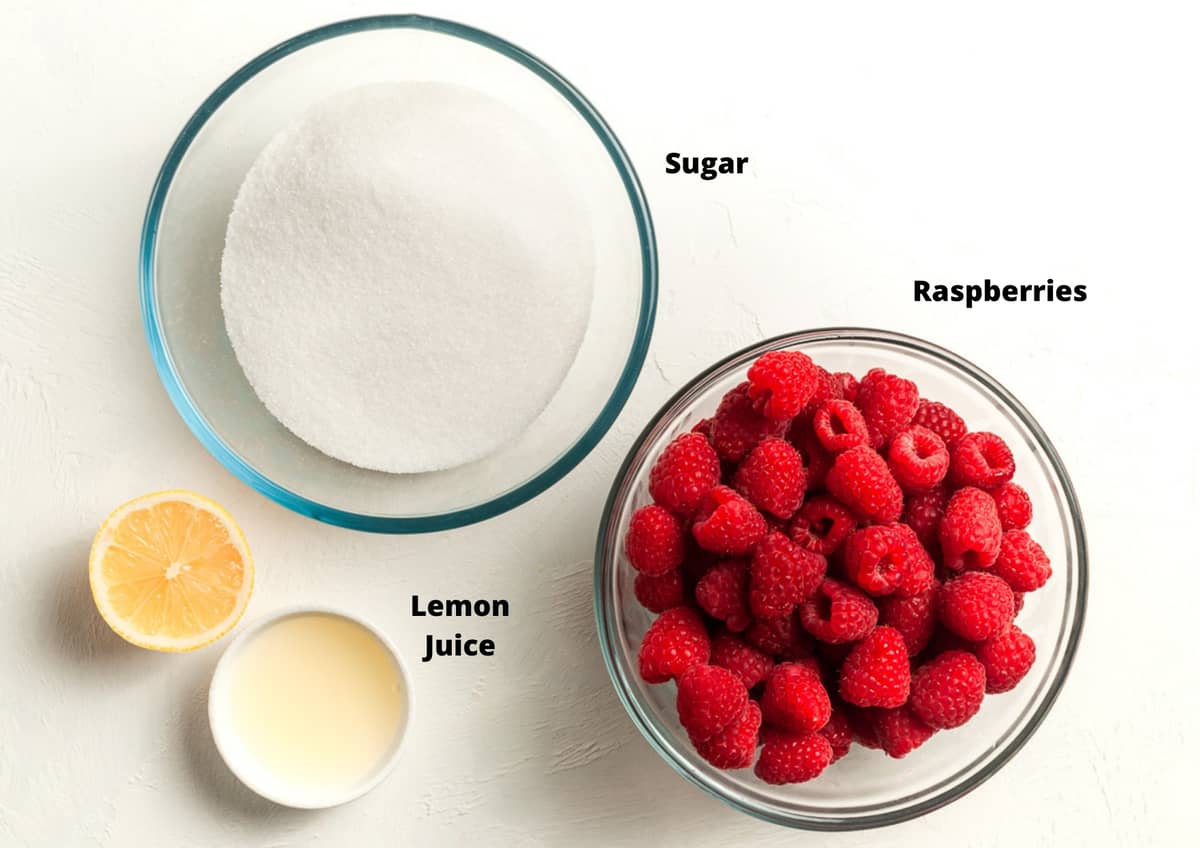
Please see the recipe card further along in the post for exact quantities of ingredients and the full method.
Raspberries – use fresh berries in good condition, ideally with some slightly unripe berries as they will contain more pectin.
Sugar – regular granulated sugar is best.
Lemon juice – use freshly squeezed lemon juice. The juice is vital, it aids in the setting of the jam.
Step by Step instructions:
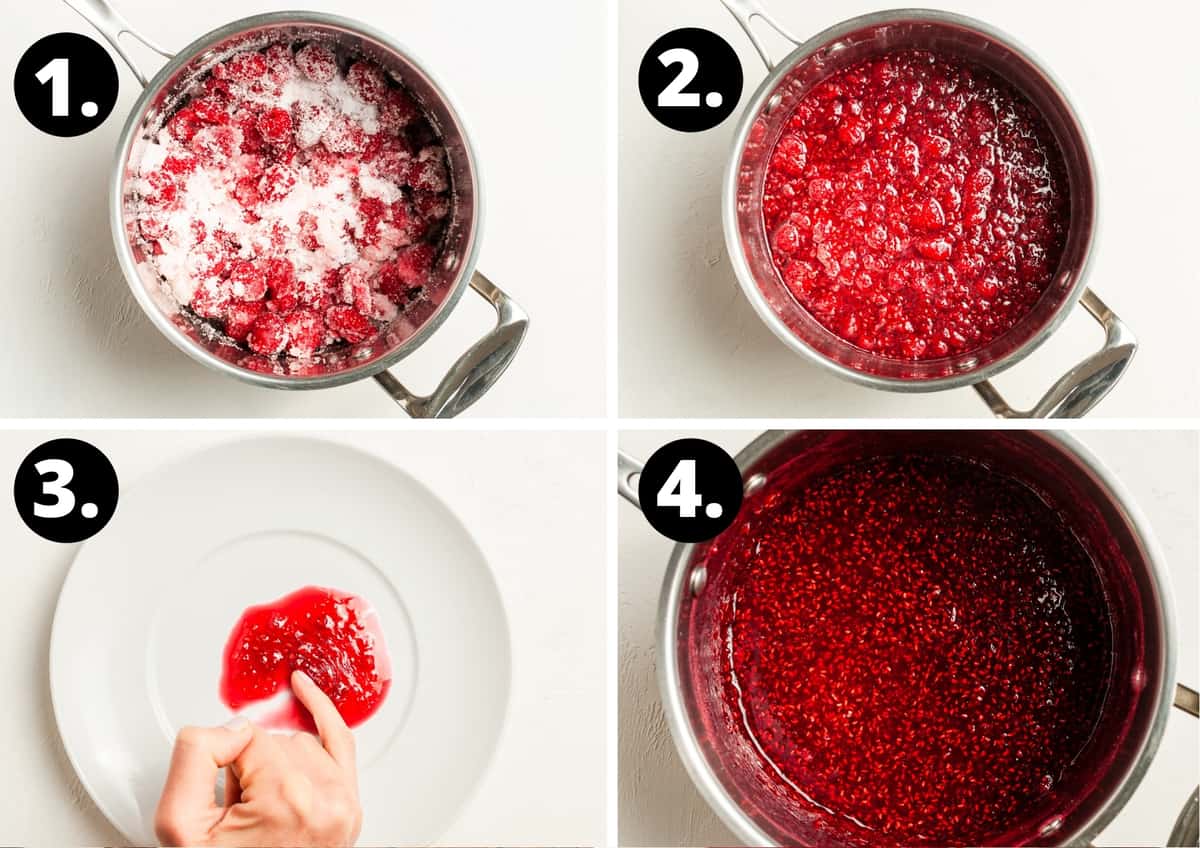
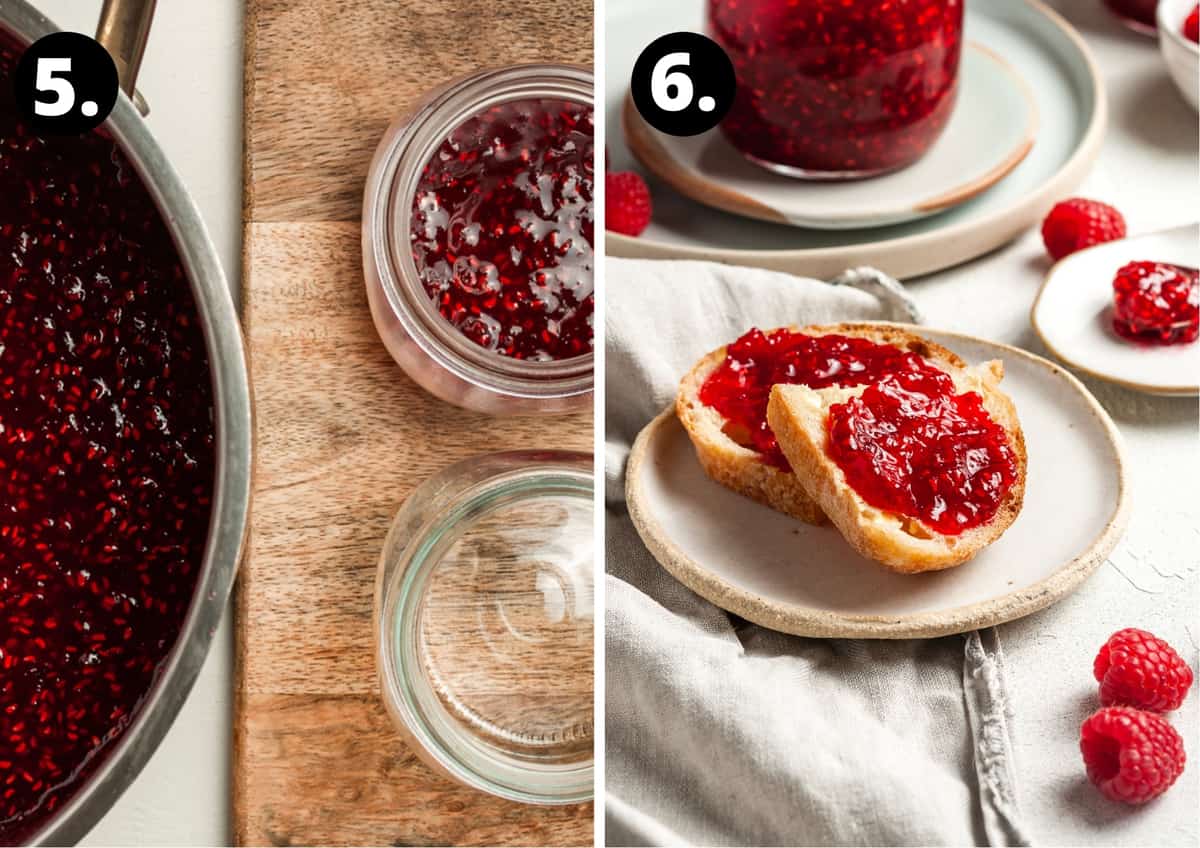
To begin, place two small saucers or plates in the freezer. You will use these to test when the jam is set.
Sterilise the jars by heating them in the oven. Full directions are in the recipe below.
- Wash and thoroughly dry the raspberries. Add the raspberries, sugar and lemon juice to a large saucepan and mix well with a wooden spoon.
- Turn the heat on low, stir until the sugar dissolves and then increase the heat to a rolling boil. Boil for 10 minutes stirring frequently. Turn off the heat and spoon a little of the jam onto a chilled saucer.
- Let it stand for 30 seconds to cool, then run your finger through it. If it wrinkles, it is ready. If it is still quite liquid, put it back on the heat and boil for a further 1-2 minutes, and retest.
- Allow the Raspberry Jam to sit for 10 minutes before carefully ladling into jars. This helps the chunks of fruit to disperse evenly throughout the jam.
- Ladle the hot jam into jars and seal immediately.
- Enjoy your delicious jam!
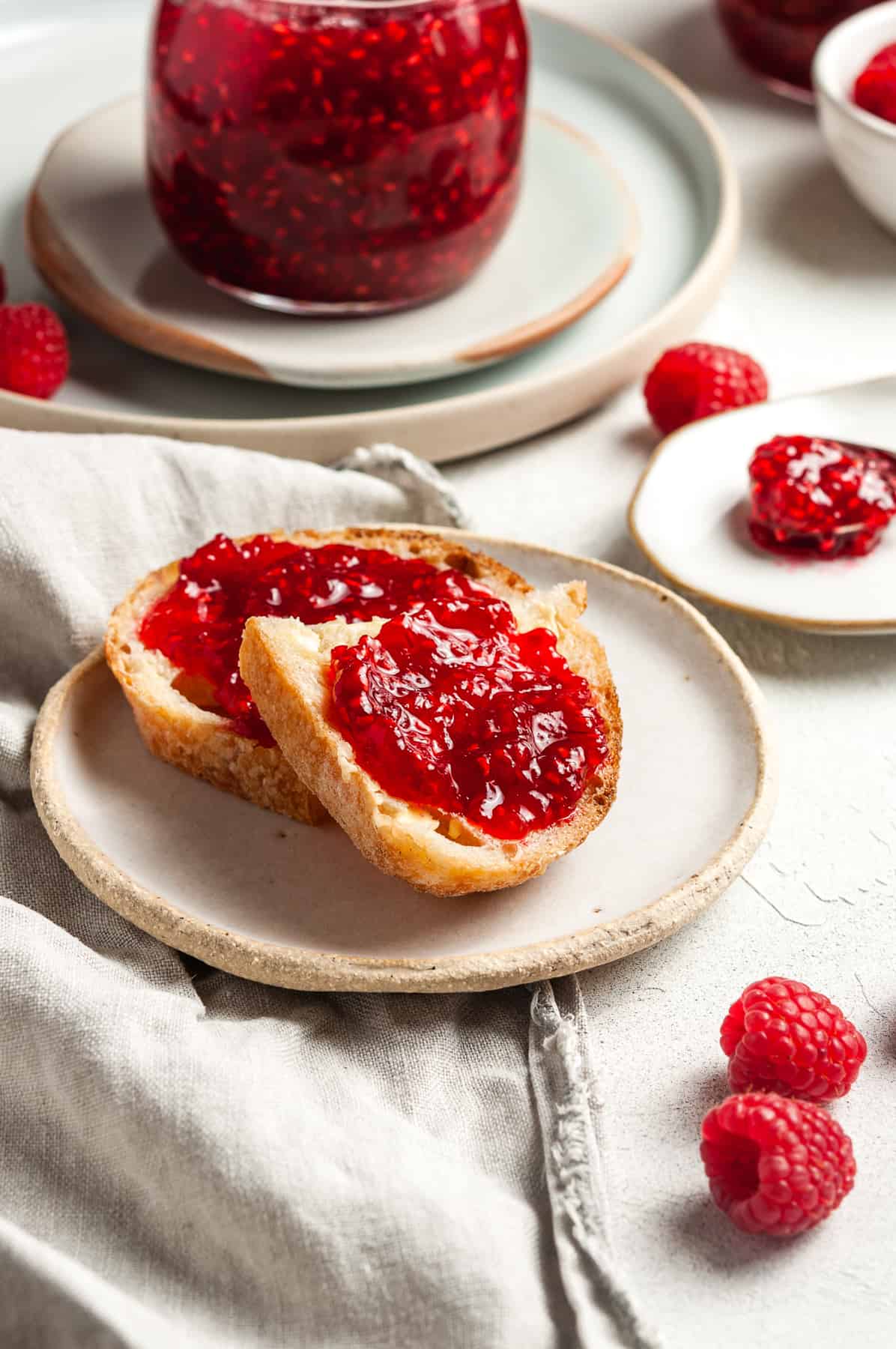
Tips for success and FAQs:
When selecting fruit, ensure that the raspberries are at their peak of ripeness. Do not use berries that are over-ripe, soft or bruised. They may cause the jam to spoil. Good quality fruit is essential to obtain the best flavour. However, it is an advantage to have some which are slightly under-ripe as they will contain more pectin and acid, both of which assist with setting the jam.
When making your own preserves, always ensure you are sterilising the jars you will store them in. This is very simple to do:
- Choose glass jars with an airtight, metal lid and ensure they have been washed in the dishwasher or by hand in hot soapy water then rinsed well.
- Preheat the oven to 130 Degrees C (270 F) and leave the jars for 15-20 minutes.
You will not need any special equipment to make this recipe. You need a large, wide saucepan. The large surface area allows faster water evaporation, giving the jam a concentrated flavour. Without a large saucepan, there is the risk of it boiling over. Avoid aluminium, copper or iron pans; the acid in the fruit may react with the pan, giving the jam a metallic taste. As well, I use a long-handled wooden spoon to keep my hand away from the bubbling jam.
If you follow the recipe instructions precisely and your jars are thoroughly sterilised, the Raspberry Jam should be shelf-stable for a year, possibly longer. When you open a jar, store it in the fridge.
Conventional jam requires a lot of sugar. When you see it weighed out it is slightly alarming but please don’t reduce the amount of sugar. The sugar not only sweetens the fruit but it helps the jam to set and acts as a preservative. If you reduce the sugar, in short, your jam may not be shelf-stable.
Lemon plays an important role in jam-making. It is high in pectin. As raspberries are low in pectin the lemon juice provides the necessary boost to aid in setting the jam. Further, the acidity of the lemon helps balance the sweetness.
Pectin is a naturally occurring starch that is found in varying degrees in fruits and vegetables. It is what makes jams and jellies firm when they are cool. When combined with acid and sugar, and cooked to a high temperature, it forms a gel. In this recipe, I add a small amount of lemon juice to boost the pectin content.
You can use recycled glass jars with metal lids that are in good condition or purchase new ones. Jars which have contained pickles are generally not suitable as they often hold the aroma. Save these for your own chutneys or pickles.
Yes, you can! Follow the recipe as written.
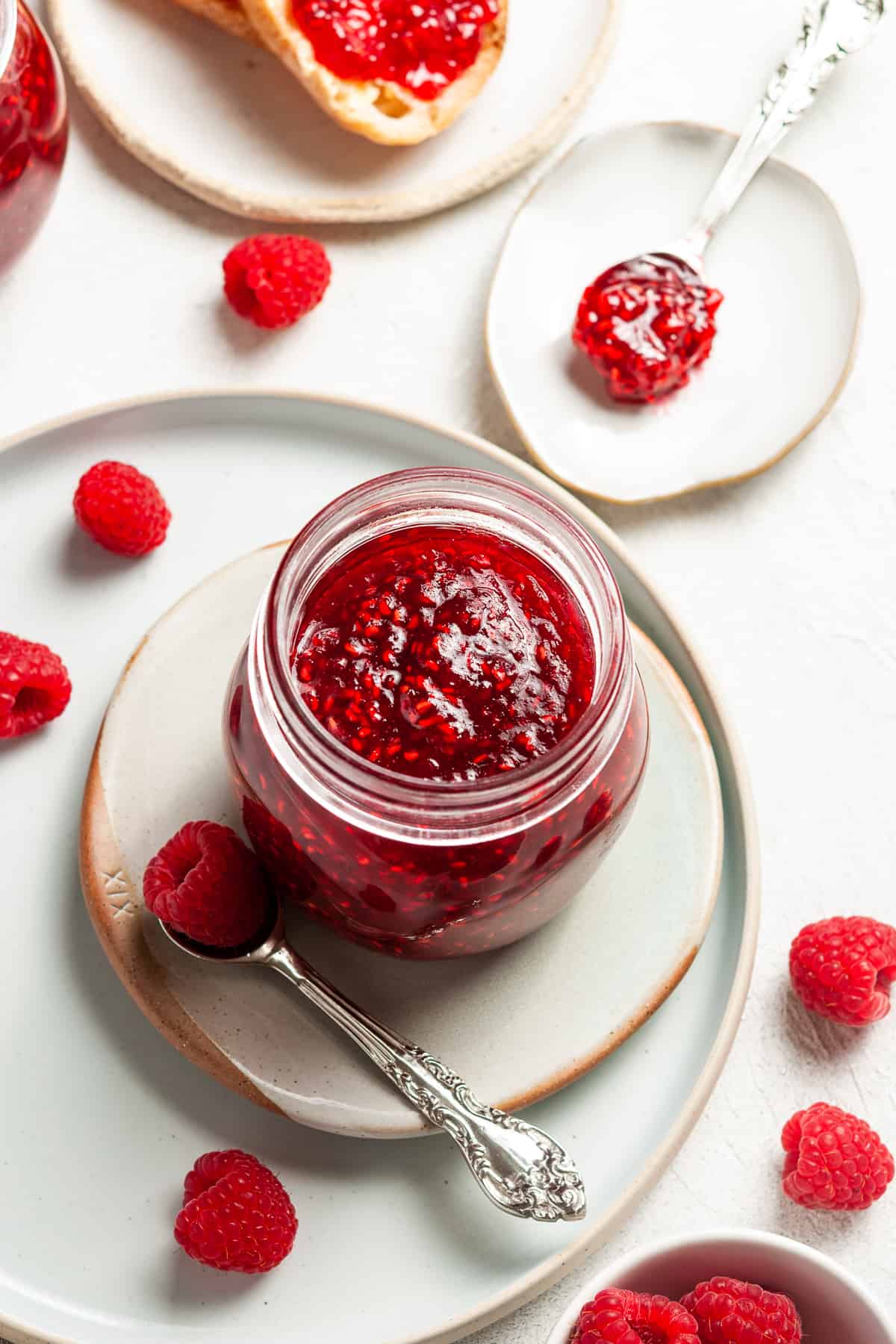
More delicious recipes for you to try:
We love to make the most of seasonal produce. Making jams, preserves, pickles and condiments is a great way to enjoy them year-round. Here are some more of our favourite recipes:
- Apricot Jam
- Preserved Chillies in Oil
- Lemon Marmalade
- Sweet Chilli Sauce
- Blueberry Jam
- Grapefruit Marmalade
- Easy Plum Jam
- Strawberry Jam
Enjoy this delicious family recipe for Raspberry Jam. I would love to hear from you in the comments below when you have given it a try!
Alex xx
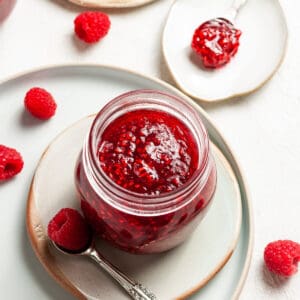
Raspberry Jam
Please note:
For accuracy, when weights are provided, we recommend weighing your ingredients. This will produce the best results. All oven temperatures listed are for fan forced.
Ingredients
- 500 g (17.5 oz) raspberries See Note 1
- 450 g (2 cups) sugar See Note 2
- 2 tablespoon (40 ml) lemon juice – freshly squeezed See Notes 3 and 4
Instructions
To Sterilise the Jars:
- Choose glass jars with an airtight, metal lid and ensure they have been washed in the dishwasher or by hand in hot soapy water then rinsed well.Preheat the oven to 130 C (265 F). Place upright jars and lids on a baking tray. Heat in the oven for at least 20 minutes, then remove and immediately fill with jam. See Note 5.
To make the Raspberry Jam:
- Place two small saucers or plates in the freezer. See Note 6.
- Gently wash the raspberries in a colander. Turn them stem side down onto some paper towel to allow them to dry. Add the raspberries, sugar and lemon juice to a large saucepan and mix well with a long-handled wooden spoon.
- Turn the heat on low and stir until the sugar dissolves. (This can take 5-8 minutes)If sugar crystals get caught on the side of the saucepan, scrape down with a spatula.
- Once the sugar is dissolved, increase the heat to a rolling boil.Boil for 5 minutes, stirring frequently. After 5 minutes, begin to check for the setting point. Your jam will likely take between 5-8 minutes, but it will depend on the width of your saucepan and how rapidly the jam is boiling.
- Turn off heat and spoon a little of the jam onto one of your chilled saucers.Let it stand for 30 seconds to cool, and then run your finger through it. If it wrinkles, even slightly, it is ready. If it is still quite liquid, put it back on the heat and boil for a further 1-2 minutes, and retest until ready. Alternatively, you could use a candy thermometer. Setting point is reached when the thermometer reaches 105 Degrees C (220 F).
- Skim any scum off the top of the jam with a spoon.
- Allow the jam to sit for 5 minutes to allow the fruit to disperse evenly.
- Carefully ladle your jam into your hot jars and put the lids on immediately. Allow the jam to cool completely. Wipe the jars to remove any spills, and store the jam in a cool, dark place.
Notes
- Ensure your fruit is freshly picked and of good quality. Avoid fruit that is bruised or over-ripe. The raspberries contain pectin which aids in the jam setting. If your fruit is older, it will contain less pectin.
- Do not reduce the amount of sugar. Whilst the sugar sweetens the fruit it also acts as a preservative and helps the jam to set. If you reduce the sugar, your jam may not be shelf-stable and may become mouldy.
- The Australian tablespoon is 20ml or 4 teaspoons. In many other countries, the tablespoon is 15ml or 3 teaspoons. Please adjust the measurement if necessary.
- Lemon juice not only balances the sweetness of the sugar, but it also contains acid and pectin which help to set the jam.
- Properly sterilising your jars is an essential process to remove bacteria that could cause your preserves to spoil. Wash the jars and lids either in the dishwasher or by hand in hot soapy water, and rinse well. Do not dry them with a tea towel. Place jars and lids on a baking tray. If you are using Kilner jars with rubber seals, be sure to remove the seals before placing the jars in the oven. The dry heat of the oven would damage the seals. Boil the seals separately in a saucepan for about 10 minutes. Heat the jars in the oven for at least 20 minutes. When your preserves are ready to bottle, use thick oven mitts or jar tongs to remove the jars. Do not place them on a cold surface as they may shatter. I place mine on a wooden chopping board which I cover with a tea towel. Always sterilise a few more jars than you think you will need. It is better to have too many jars than not enough.
- The chilled plates are used to quickly cool the jam when testing the setting point.
- Always choose a large, wide saucepan that has enough height to enable the jam to boil vigorously. More surface area means the liquid will evaporate faster; having sufficient height means you can boil the jam at a higher heat and maintain the fresh flavour of the raspberries. Avoid aluminium, copper or iron pans; the acid in the fruit may react with the pan, giving the jam a metallic taste.
- Do not use a metal spoon, it will become very hot. A long-handled wooden spoon is important to avoid being burnt by a splash from boiling jam.
- My jam reached its setting point about 5 minutes after it began to boil rapidly. Boiling time will vary depending on the size of your saucepan and the heat that you apply.
- If you prefer smooth jam, use an immersion blender carefully once you have taken the raspberry jam off the heat.
- If your finished jam has not set as much as you would like, don’t worry, it will still be delicious stirred into some plain yoghurt or served over our No-churn Vanilla Ice Cream. Or, if it is slightly over-set and is very firm, it will be a lovely accompaniment on a cheese board.
- Please note, the nutritional information is based on one whole jar. The nutritional information is an estimate only.
Nutrition Estimate:
Nutritional Disclaimer:
The nutritional information is an estimate only, and is derived from online calculators. For accurate results, we recommend calculating the nutritional information based on the ingredients and brands you use.

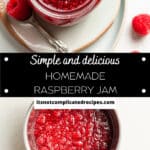
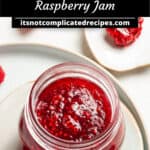
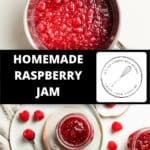
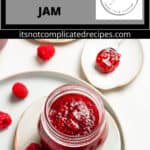
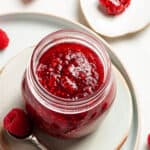
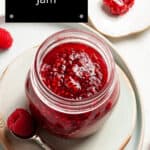
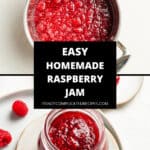



Jessica
delicious 😋
Alexandra Cook
Thanks, Jessica! 🙂
Alex xo
Colquhoun
Tried this recipe with previously frozen berries. Works beautifully. So happy to have a recipe not requiring bought pectin.
Alexandra Cook
Thank you so much! 🙂
I am so happy you enjoyed this recipe, and appreciate you taking the time to let me know. Alex xo
Clemmie
Absolutely gorgeous. So easy and quick to make
Alexandra Cook
Hi Clemmie 🙂
Thank you so much. I am so pleased to hear that you enjoyed this recipe.
Alex xo
Nathalie
will this jam stay shelter stable without canning it ?
Alexandra Cook
Hi Nathalie,
Thank you for reaching out 🙂
For the jam, I follow the method that my great grandma used – the hot sterilised jars and the hot jam with the lids put on immediately cause a vacuum to form a seal as they cool. As the jam has just been vigorously boiled, we don’t boil it again in a water bath. The jars are shelf-stable for 12 months, and only need to be refrigerated once they have been open.
This is a method most commonly used in Australia/UK, although I am aware that in the USA/Canada water bath canning is the more popular method.
If you prefer to water bath, you certainly can, and you can find more information here.
Please feel free to reach out with any questions and I hope you’ll enjoy your jam 🙂
Alex xo
Anne
Hi Alex, I made the jam and it worked out really well. Your instructions are very clear and I followed them very carefully and had everything ready as it was my first time to make jam.
I used frozen raspberries and I think the jam was a little sweet and I wonder if the frozen ones weighed more than fresh (so my proportions were off?). Anyway, it was a great success and I wouldn’t hesitate to try other jams, so thank you, Alex.
Alexandra Cook
Hi Anne,
Thank you so much for giving the recipe a try 🙂
I am so glad you found the instructions clear.
Your proportions shouldn’t have been much off from using frozen raspberries, unless they were super icy and had a lot more water in them, which would alter the weight.
Assuming they weren’t, I read once that frozen might only vary in weight by 15-20 grams for a whole bag.
You could certainly use a little extra fruit next time, if you wish. We actually use a little more sugar in the raspberry than we do in some of our other jams, as raspberries can be tart. In general, we use a ratio of 3/4 of sugar to the amount of fruit.
I hope that helps, and you’ll have to let me know what jam you plan on trying next 🙂 Alex xo
Ani
Hi there. How much headspace should you leave in the jars before sealing?
Alexandra Cook
Hello Ani!
Thanks for your question. You’ll want to fill the jars to the brim – we don’t want gaps.
The one exception to this is if you plan on freezing any of the jars – in that case, you’d want to leave about a 2-3cm gap as the jam will expand when frozen.
I hope that helps! Alex xo
Sully
Thank you for such a delicious jam recipe! Your instructions were so easy to follow.
If I could give ten stars I would.
Thank you so much for sharing this amazing recipe!! ❤️
Alexandra Cook
Hello Sully!
Thank you so much for giving this recipe a try – I am so happy to hear you enjoyed the jam so much 🙂
Appreciate your comment and you taking the time to let me know! Alex xo
Anita
Could I use frozen raspberries?
Alexandra Cook
Hi Anita,
You sure can – I love to do this when they’re not in season. Just make sure they’re good quality and were frozen when they were fresh! 🙂 Let me know if you give it a try!
Alex xo
BB
If I know I’m using all of the jam within 24 hours do I have to go through the process of sterilizing jars?
Alexandra Cook
Hello BB! 🙂
We still recommend having the jar hot before you add the jam – this avoids potential breakage from the sudden temperature change.
To make things simple, you could use just the one jar.
Or, you could allow the jam to cool slightly in the pan and then add to a heat proof bowl, allow to cool and then store in the fridge.
Hope that helps! Alex xo
Mary Grace Phillips
So easy. It tastes delicious! BUT, you have to cook much longer than 5-8 minutes. I cooked using a candy thermometer until it reached the stated temperature, and it took the guesswork out of it. It’s so beautiful! I can’t wait for the breakfast crew to try it out in the morning!
Alexandra Cook
Hello Mary,
Thank you so much for making my recipe.
The cooking time will vary depending on the size of your pan, how vigorous it is boiling and even the quality of the fruit. 🙂
Using a thermometer does make it easy, doesn’t it? 🙂
I appreciate your comment and hope you’ll all enjoy eating the jam.
Alex xo
Haily
My 1st time making jelly and it turned out perfect! I gave a few jars to my neighbors, thank you for the recipe. Merry Christmas!
Alexandra Cook
This is lovely to hear, Haily! 🙂
Merry Christmas to you too! Alex xo
Scott
Great recipe. The only thing I did different, was run it through a strainer to get rid of the seeds.
Alexandra Cook
Hi Scott,
Thanks so much for trying this recipe 🙂 Alex
Kimberley
Hiya! I’m going to try this recipe tonight, I was planning to half the ingredients as I don’t need a lot (making a bakewell tart). Does it make a chunky jam or would I have to mash it if I want it more smooth? Thanks.
Alexandra Cook
Hi Kimberley,
Thanks for your comment!
This is on the smaller side of batches of jam anyway – so just make sure you have enough for your tart 🙂 It will yield approximately 3 x 210ml (7 oz) jars.
If you do make a half recipe, just start to check the jam setting point a couple of minutes earlier.
For a smoother jam, you can mash the fruit a little bit as you’re dissolving the sugar.
Hope that helps! Thanks, Alex xo
Betty
Super easy, delicious and wow – tastes so good. I am a jam newbie and this was just so simple x thank u!
Alexandra Cook
Hello Betty,
I am so happy you had success with this recipe 🙂
Thanks so much for sharing! Alex xo
Valerie Stoner
I love the title of this website!
BUT..this is the most complicated recipe I’ve seen for Raspberry Jam
Who really needs to wash and then place individual berries upside down to drain,,,,??
Alexandra Cook
Hi there Valerie!
I am glad you like the website name 🙂
We try to provide as much detail as possible with our recipes.
In respect to the raspberries – we prefer to wash our fruit, as it helps to get rid of any toxins if non-organic, or bugs, dirt etc if the fruit is organic.
Turning the fruit upside down to drain gets rid of the extra water which we don’t want diluting the jam.
We don’t think washing the fruit is an overly complicated step to ensure the best quality result 🙂
Kind regards,
Alex
Shelby Salas
Made the raspberry jam and it came out great!! Only questions I noticed the shelf life is 1 year before it’s opened but about how long does it last after being opened?
Alexandra Cook
Hi Shelby!
So happy you enjoyed this recipe 🙂
Once opened, store in the fridge and always use a clean spoon when removing the jam.
The jam will last for 4-6 weeks in the fridge once opened.
Enjoy! Alex xo